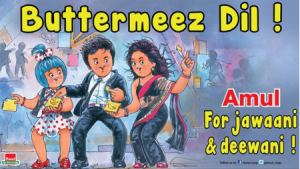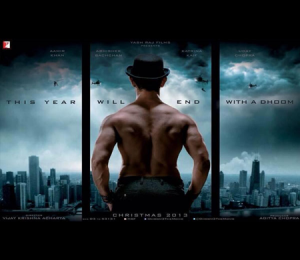Devika continues to churn out more posts looking into areas that we’ve not often covered on this blog! This is her 5th entry to our Fellowship and is yet another very interesting read. You can view her previous posts here.
Amul girl and her Filmi Avatars
Amul ads are known for their excellent depiction of some of the burning issues in the country and also for the movie spoofs that they create. Take for instance, ‘Buttermeez Dil’, the movie spoof of ‘Yeh Jawaani Hai Deewani’ (Other popular films which have been the subject of Amul ads include ‘Bhaag Milkha Bhaag’ and ‘Chennai Express’).
The latest Amul poster to hit the billboards is the movie spoof of Aamir Khan-blockbuster ‘Dhoom 3’–
The Amul ad is a recreation of one of the posters of Dhoom 3–
Amul’s spoof ad depicts the Amul girl in the Kamli avatar of Katrina Kaif in Dhoom 3 and is endearing. Unlike the controversial Dhoom 3 movie spoof by AIB, the Amul ad has been received well; it does, however, make for an interesting discussion on whether the Amul ad can be considered a form of character merchandising (more specifically, ‘image merchandising’- where fictional characters are played by real life persons) and if this be the case, should Amul have sought a license from Yash Raj Films (the producers of Dhoom 3) or the actors, Katrina Kaif and Aamir Khan before depicting the characters of the film in its advertisement?
Merchandising is ‘sales promotion as a comprehensive function including market research, development of new products, coordination of manufacture and marketing, and effective advertising and selling’.
Character merchandising is ‘the adaptation or secondary exploitation by the creator of a fictional character or by a real person or by one or several authorized third parties of the essential personality features (such as the name, image or appearance) of a character in relation to various goods and/or services with a view to creating in prospective customers a desire to acquire those goods and/or to use those services because of the customers’ affinity with that character.’ Simply, character merchandising may be understood as a form of trademark licensing by which the creator of a fictitious character licenses the right to use the character with respect to merchandising of goods/services.
For e.g. if I want to use the image of Ronald Mc Donald (the mascot of Mc Donald’s) on t-shirts that I manufacture, I will require a character merchandising license from Mc Donald’s Corporation.
Character merchandising also comes into play where the name of a public figure is used to advertise goods/services. For example, a label attached to a clothing line bearing the name of ‘Audrey Hepburn’ will require license from the estate of Audrey Hepburn to enable the fashion house to use the same (more accurately known as ‘personality merchandising’).
Character merchandising helps bring in significant revenue for the creator of a character by allowing commercial exploitation of the characters created by them, for example, Harry Potter and Disney characters used on a gamut of merchandise ranging from bags to t-shirts. It is estimated that Disney earned $US 28.6 billion dollars from merchandising and licensing in 2010 (almost 20 times of its theatrical revenue).
In case of Amul ads, one might argue that Amul has not actually used the character on the packaging of the dairy products that it sells. However, I argue that the right to use the character is not limited to use on packaging of the goods but also the advertisements promoting the sale of those goods, i.e., character merchandising protection extends not only to marketing but also advertising of a product. This is evident from the definition of ‘merchandising’ quoted above.
While it is also true that Amul has created movie spoofs earlier and done so without courting any controversy, the reason why this particular Dhoom 3 spoof catches my fancy is the extensive merchandising that Dhoom 3 producers have done in order to commercially exploit the film characters which they created; it is estimated that this is the first time a Bollywood film has been promoted on such a large scale via character merchandising.
Trademark claims in cases of character merchandising are brought under s. 27 of The Trademarks Act for passing off. For such a claim to succeed, the elements of passing off (i.e. misrepresentation by defendant, goodwill/reputation of plaintiff, actual loss/likelihood of future loss to plaintiff) must be proved by the plaintiff.
Character merchandising protection is also afforded under copyright law where the creator of a character has the right to commercially exploit the character created by him.
Additionally, the actors Aamir Khan and Katrina Kaif whose characters have been depicted in the Amul ad maight succeed in a suit for false endorsement against the advertisers. This has been held in Eddie Irvine v. Talksport ([2003] EWCA Civ 423)
The advertisers in this case would most likely resort to the ‘fair use’ provision (which allows fair dealing in a work including satire/parody) claiming that they have spoofed innumerable movies in the past and this should not be any different; they might also argue that the Dhoom 3 butter ad is actually a tribute to the film. However, the primary purpose of advertisements is to sell products and advertising can significantly impact consumer choices; one of the reasons why Pepsi sells and a beverage ‘X’ does not is because of the celebrities endorsing the carbonated drink; this is why companies spend considerably on advertising.
If in future, a claim for character merchandising is filed successfully against Amul ad-makers, it would significantly change the way Amul products are advertised and might just result in the Amul girl quitting her filmi avatars.




Great post. The only reason why Amul is not facing such suits is that the ads are joint promotion. Amul cleverly creates ads on current topics and in almost all cases it also promotes the subject matter that they have parodied. They hardly malign anyone (unless they are depicting political scams). Since its a win win situation for both of them, there is no litigation. I had discussion regarding this with a very senior legal guy working for Voltas (Voltas was national distributor for Amul for a long time) in a Tata IP meet, while I was in TCS.
Wow! This explains a lot. I never thought that Amul might actually be promoting the film. Thank you for the information 🙂
The concept of reverse advertising also is there. A brand like Amul using Dhoom 3 theme for their satire lead to marketing of Dhoom 3. The poster is able to create curiosity in minds of even those people who have no clue what ‘Dhoom 3’ is.
Hi Swaraj,
Interesting read indeed.
You said it rightly that Amul can argue that they have done it before and this time its no different. However, I have two more lines of argument that I would like to hear your views on.
First is that the characters of Dhoom 3 are not commercial characters like that of McDonalds. Characters of Dhoom 3 belong to a movie story and not to a range of products of services. They are more subject to copyright protection rather than a trademark protection unless such protection is specifically sought for.
Secondly, Amul by this poster is not exploiting the brand value of Dhoom 3, it rather is exploiting the public’s knowledge of current affairs. Dhoom 3 is in talks for breaking box office records and is in news daily since a month now. No doubt its all efforts of the Dhoom 3 marketing team, but Amul is a brand since much longer now. Also, Amul is known for satirical cartoons on current affairs and not for satirical cartoons on commercially upcoming or successful ventures. No doubt Amul’s advertisements/cartoon posters like this are also contributing to brand value, but it will be a hard time for Dhoom 3 marketing team to quantify the additional sales their characters have led to for a Well Known and comparably ancient brand like Amul, considering Dhoom 3 has popped up in recent months and will vanish from public’s minds in max few years cause its just a movie in box office and not a McDonald’s character which is going to sell burgers for decades to come.
If what you are suggesting turns real than I believe it will be big blow to freedom of speech. The satirical cartoons published in the newspapers are of similar nature. If Amul can profit from such posters than for sure ToI, The Hindu, DNA, etc. are profiting byusing public/commercial figures in their satirical cartoons which they daily publish in the news papers.
Hi,
The characters in a film may not ordinarily be “commercial characters”. However, in case of ‘Dhoom 3’ specifically, the characters in the film were being commercially exploited through character merchandising (e.g.- Katrina’s doll versions post Dhoom 3)..in such cases, Dhoom 3 producers might be able to bring an action for passing off (because the characters are ‘unregistered trademarks’)…proving the 3 elements of passing off may be difficult in this case because clearly, Amul is such a well-known brand that an intention to ‘misrepresent’ cannot be imputed to Amul..had this been a lesser known brand ‘X’, YRF might successfully argue that the brand attempted to ride on the success of Dhoom 3
Also, as regards your point about the satirical cartoons published in national dailies, I think that character merchandising might not apply…This is for 2 reasons:
firstly, where political figures are used in cartoons for the purpose of satire one cannot really associate ‘publicity rights’ with political figures…rarely do we see political figures using their image to sell any product/service..in stark contrast, movie stars frequently enter into endorsement contracts
secondly, cartoons such as those published in newspapers are purely for the purpose of ‘satire’…in an advertisement, satire is used to sell goods/services…on the other hand,it is unlikely that cartoons in a newspaper (which often feature as a small column in the newspaper) are actually the reason behind the sale of the newspaper
Nice observation!
However, such character portrayal is an ordinary but creative replication of the ordinary situation where commercial ads on TV involving highly popular brands such as Pepsi and Kit Kat use character portrayal or simulate other commercial outputs/situations. For ex, see the foll ads: http://www.youtube.com/watch?v=xLIFi5rmuDI; http://www.youtube.com/watch?v=puineN1UMto. Notice how a famous bollywood song is replicated in the former ad involving Kit Kat and a famous bollywood star’s trademark style is replicated in the latter ad involving Pepsi….
Further, Amul’s character portrayal does not negatively portray such commercial enterprises…these are spoofs, quite about as harmless, as works by political cartoonists. So, goodwill/reputation of the would-be Plaintiff as envisaged….
Yes, that is correct…in fact, passing-off under trademark is harder to prove in cases of character merchandising..this is because of the requirement to prove the three elements of passing off…
would nt be affected
Somehow the author has not heard of a concept called Parody!!!
Hi Maneesh,
Thank you for the comment. As pointed out in the penultimate para of the post, the advertisers are likely to resort to the fair use provision [s.52 (1) (a)] under The Copyright Act..however, this provision allows for the use of the copyrighted work for personal use/criticism/review…a parody is not expressly provided for as a defence under The Copyright Act and therefore, it remains to be seen whether a parody of the work will be allowed..it has also been stated in the post that where the copyright owners (the film-makers) can prove that this is in fact a commercial exploitation of their copyrighted characters (Amul used the copyrighted work in advertising), the defence of parody may not stand.